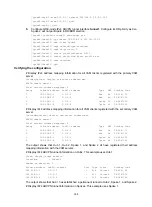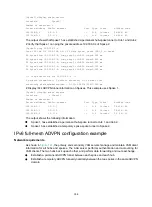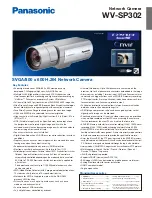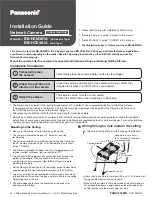
355
[Spoke2-ospf-1-area-0.0.0.0] network 192.168.2.0 0.0.0.255
[Spoke2-ospf-1-area-0.0.0.0] quit
[Spoke2-ospf-1] quit
5.
Configure GRE-mode IPv4 ADVPN tunnel interface
tunnel1
. Configure its DR priority as 0 so
Spoke 2 will not participate in DR/BDR election.
[Spoke2] interface tunnel1 mode advpn gre
[Spoke2-Tunnel1] ip address 192.168.0.4 255.255.255.0
[Spoke2-Tunnel1] vam client Spoke2
[Spoke2-Tunnel1] ospf network-type broadcast
[Spoke2-Tunnel1] ospf dr-priority 0
[Spoke2-Tunnel1] source gigabitethernet 2/0/1
[Spoke2-Tunnel1] tunnel protection ipsec profile abc
[Spoke2-Tunnel1] undo shutdown
[Spoke2-Tunnel1] quit
Verifying the configuration
# Display IPv4 address mapping information for all VAM clients registered with the primary VAM
server.
[PrimaryServer] display vam server address-map
ADVPN domain name: 1
Total private address mappings: 4
Group Private address Public address Type NAT Holding time
0 192.168.0.1 1.0.0.1 Hub No 0H 52M 7S
0 192.168.0.2 1.0.0.2 Hub No 0H 47M 31S
0 192.168.0.3 1.0.0.3 Spoke No 0H 28M 25S
0 192.168.0.4 1.0.0.4 Spoke No 0H 19M 15S
# Display IPv4 address mapping information for all VAM clients registered with the secondary VAM
server.
[SecondaryServer] display vam server address-map
ADVPN domain name: 1
Total private address mappings: 4
Group Private address Public address Type NAT Holding time
0 192.168.0.1 1.0.0.1 Hub No 0H 52M 7S
0 192.168.0.2 1.0.0.2 Hub No 0H 47M 31S
0 192.168.0.3 1.0.0.3 Spoke No 0H 28M 25S
0 192.168.0.4 1.0.0.4 Spoke No 0H 19M 15S
The output shows that Hub 1, Hub 2, Spoke 1, and Spoke 2 all have registered their address
mapping information with the VAM servers.
# Display IPv4 ADVPN tunnel information on Hubs. This example uses Hub 1.
[Hub1] display advpn session
Interface : Tunnel1
Number of sessions: 3
Private address Public address Port Type State Holding time
192.168.0.2 1.0.0.2 -- H-H Success 0H 46M 8S
192.168.0.3 1.0.0.3 -- H-S Success 0H 27M 27S
192.168.0.4 1.0.0.4 -- H-S Success 0H 18M 18S
The output shows that Hub 1 has established a permanent tunnel to Hub 2, Spoke 1, and Spoke 2.
# Display IPv4 ADVPN tunnel information on Spokes. This example uses Spoke 1.
















































